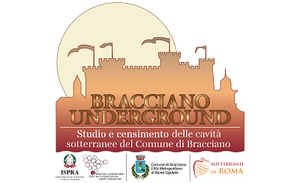Bracciano Underground Project - Study inventory of underground cavities of Bracciano Municipality
In Italian historical towns, human-induced sinkholes are mainly represented by networks of underground cavities of different types (i.e. quarries, caves, cisterns and hydraulic networks) constructed since ancient times to present time. In Italy, in the last decades, numerous sinkholes have occurred in urban areas due to collapse of the vaults of underground cavities; such failures are related to either natural causes (e.g. intense and prolonged rainfall) or anthropogenic causes such as losses from hydraulic networks, excavations or total lack of maintenance of hypogeal structures.
This situation has determined an increasing risk for people and infrastructures due to lack of specific actions addressed, first of all, to the implementation of a detailed inventory of underground cavities in urban areas as basic element to assess susceptibility/hazard due to sinkholes. ISPRA, Department for the Geological Survey of Italy, has implemented Inventory of undeground cavities and established several agreements with local administrations for the assessment of sinkholes susceptibility in urban areas as a support to risk mitigation policies and safety planning actions. On this subject, ISPRA is providing technical support to the Municipality of Bracciano, in the province of Rome, through a 3-years project entitled ‘Bracciano Underground’ with the aim of mapping, conservation/reinforcement and historic and archaeological valorisation of underground cavities.
The subsoil of Bracciano is characterized by numerous underground cavities that constitute large spaces or narrow tunnels; it is possible to recognize hydraulic tunnels, cisterns, caves, as well as underground walkways. These anthropogenic cavities were made since historical times and carved, in the volcanic rock which forms the cliff where the historic centre is located. In the ancient village, during the Middle Ages, it was almost a common practice the excavation of underground cellars beneath houses or in the back of shops and warehouses; such practice has increased, often illegally, in the following epochs. Only in a few cases is it possible to assume the construction of such cavities in periods prior to Middle Ages. From the same historical period until the recent time, some hypogea were used as stables that represent the most typical feature of the village. Some older underground structures are also diffused, built, in Etruscan or Roman times, used as cisterns for the collection of rainwater. Many underground cavities have been abandoned over time, closed and/ or used to landfill of waste and waste materials, or filled with debris of various types. Hydraulic tunnels and walkways also wind through the streets of the village beneath the urban streets. The state of degradation of these underground spaces, their exact extent and mapping still unknown, has caused over time to sinkholes (anthropogenic sinkholes) and failure of road surfaces. Due to the above issues, the ‘Bracciano Underground’ project is aimed at implementing: a) a detailed inventory and mapping of hypogeums in the urban area; b) laser scanning surveys of cavities that exhibit the most critical static conditions; c) multi-method superficial and underground geophysical investigations with the purpose of detecting the cavities and providing a model of the subsoil for further geotechnical analysis.
Underground cavity in the historical centre of Bracciano, first contribute

